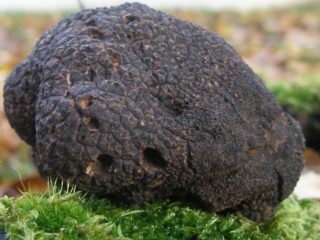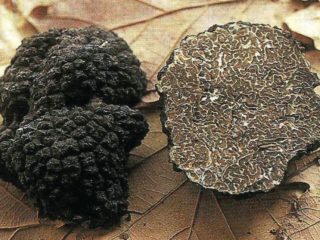Content
Truffles are rare in the Moscow region, and the search for these mushrooms is complicated by the fact that they grow underground. That is why in the old days they were often searched for with the help of dogs trained to smell the truffle. Although even now some mushroom pickers use animals to search.
In addition to the Moscow region, various types of truffles grow in Russia in the Caucasus, Crimea and the Black Sea coast.
Are there truffles in the Moscow region?
There are truffles in the Moscow region, but it is very rare to find them. There are many types of this mushroom, however, only three grow in the Moscow region: summer (also black Russian), white and Duron.
Black truffle (lat. Tuber aestivum) or scorzone is an irregularly shaped mushroom with a rough, warty surface. Its sizes vary from 3 to 9 cm in diameter. The pulp of young specimens is quite dense, yellowish-white, but in adult mushrooms it becomes loose and brown with many whitish veins.
White truffle (lat. Choiromyces meandriformis) or Trinity truffle is the most common variety in Russia. However, it has no special value, unlike real truffles.In the old days, this mushroom was also called Polish.
The fruit body of this species is white and powdery. The surface of mature mushrooms gradually acquires a marble-like appearance with pronounced dark veins. The color of ripe fruiting bodies is yellowish-brown.
This is a fairly large species, it can reach 6-8 cm in diameter, and the mushroom weighs about 350-400 g. Its shape is tuberous, slightly flattened. The pulp is elastic, light, somewhat reminiscent of potato. It tastes like walnuts or deep-roasted seeds.
Another species that can be found in the Moscow region is the white Duron (lat. Tuber excavatum). It is found throughout the entire European part of Russia. The size of the mushroom does not exceed 4 cm, it weighs approximately 65-80 g. The aroma of this variety is very pleasant, sweetish-spicy. Medium density pulp. The surface of the fruiting body is colored in an ocher-flesh shade.
A photo of a white Duron truffle found in the Moscow region is presented below.
When does truffle season begin in Moscow?
The start of collection may differ for each species. On average, the height of the truffle season is in September, sometimes it can shift to a later date. There are also practically empty seasons, when there are almost no mushrooms.
Specific collection dates in the Moscow region look something like this:
- black summer truffle bears fruit from mid-June to the end of September;
- Trinity truffle in the Moscow region is harvested from August to November;
- The white Duron truffle actively bears fruit in September-November.
Where do truffles grow in the Moscow region
Truffles are not marked on the map of mushroom places in the Moscow region, since they are extremely rare.In the old days, truffle fishing was carried out in the north and south of the Moscow region.
White truffle is the most unpretentious subspecies. It can grow on sandy and clay soils of both deciduous and coniferous forests. This species forms mycorrhiza with oaks, aspens, birch, linden and rowan, and groups of fungi are also found under hawthorn and hazel.
Black truffle is searched for in deciduous and mixed forests. In the Moscow region it grows under oaks and beeches, and can also be found next to hazel. The preferred soil type is calcareous.
The Duron white truffle is able to form alliances with many coniferous and deciduous trees. Most often these are oaks, pines, larches and birches.
How to find truffles in the Moscow region
Finding truffles near Moscow is very difficult, not only because of its low prevalence. The fact is that it grows underground, and only sometimes the top of the mushroom peeks out from under it. Therefore, people focus on additional signs of mushroom places. For example, very often midges hover over a truffle point. In particular, the smell of the mushroom attracts red flies.
In addition, places where truffles accumulate are sometimes revealed by small bumps on the soil surface, which are covered with small cracks. It is better to look for mushrooms in light clearings and forest edges.
How to collect truffles in the Moscow region
It is almost impossible to find this mushroom on your own in the Moscow region. Mushroom pickers usually stumble upon it by accident.It is better to conduct a targeted search for mushrooms with the help of pigs or trained dogs.
Pigs (male) are able to smell the truffle smell from tens of meters away and do not need special training, but using them is risky - once a pig finds a mushroom spot, it can quickly eat the find. To prevent this from happening, animals are muzzled.
Dogs, on the contrary, are better able to detect the truffle scent of a female. The advantage of using dogs is that they do not eat the find, however, their training takes a lot of time, and such animals are very expensive.
You can learn more about how to collect truffles in the Moscow region from the video below:
Conclusion
Truffles are very difficult to find in the Moscow region - the fruiting bodies are hidden underground, so it is better to take specially trained dogs with you to search. Unlike pigs, they are not interested in the find from a gastronomic point of view, so there is no risk of losing the harvest.
Since searching for truffle sites in this area is extremely difficult, it is much easier to grow a valuable species yourself - the climate of the Moscow region allows this. The growing process is labor-intensive, and the harvest is very small, but even so it is more profitable than long wanderings through the forest.











